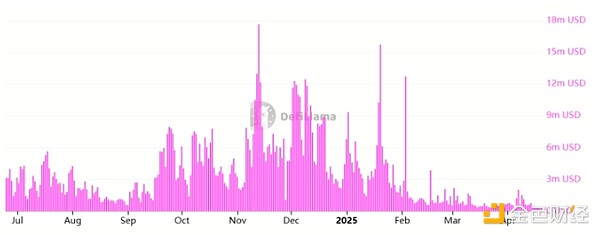Author: Marcel Pechman, CoinTelegraph; Compiler: Tao Zhu, Golden Finance
After 16 days of selling pressure due to macroeconomic uncertainty and a sharp drop in on-chain activity, the price of ETH has climbed above $1,700. Despite the rebound, Ethereum still underperforms the overall altcoin market by 23% so far this year.
Some traders claim that ETH will usher in a bull run by providing a "truly" decentralized and permissionless financial system, but is this really the case?

Unlike competitors such as Solana, TRON, and BNB, Ethereum is one of the few major cryptocurrencies that has failed to hit a new all-time high in 2025.
Some critics have argued that abandoning proof-of-work mining would eliminate the competitive advantage Ethereum once had over its competitors.
Falling Ethereum Fees Portend Ethereum Price Weakness
Eventually, Ethereum could outperform its competitors, even if only for a short period of time, and influencers calling for a "bottom" will celebrate their predictions despite the lack of strong fundamentals to support lasting price growth. However, given that Ethereum fees have fallen 95% since January, the likelihood of an immediate ETH surge seems low.

Ethereum network daily fees. Source: DefiLlama
Low demand for data processing on the Ethereum network has led to inflation in ETH as the built-in destruction mechanism is insufficient to balance the issuance of new coins to pay staking rewards.
Despite a clear lead in total value locked (TVL), traders are generally uninterested in this metric as it does not translate into higher demand for the Ethereum network or increased scarcity for ETH.
As a result, optimism among ETH holders is declining even as Ethereum’s fundamentals improve, while competitors (particularly Solana and XRP investors) are hopeful that their spot exchange-traded funds (ETFs) will be approved in the United States. Currently, spot ETFs in the United States are only available for Bitcoin and ETH, so additional issuance could reduce potential institutional demand for altcoins.
More worryingly, U.S.-listed spot Ethereum ETFs saw $10 million in net outflows between April 21 and April 23, while similar BTC instruments saw record inflows.
History shows that ETH price rallies rarely last long
Historical evidence shows that ETH's performance is not durable compared to its competitors, which reduces the likelihood of a sustained rise in ETH.

Ethereum's market share among altcoins. Source: TradingView / Cointelegraph
For example, its market share in altcoin capitalization reached a low of about 26.5% in June 2022, when the ETH price fell below $1,100. After a rapid rise to $2,000 in August 2022, momentum gradually weakened, and less than three months later, the price of ETH fell below $1,200. This sudden correction may have frustrated many investors, as they had to wait eight months for ETH to reclaim $2,000 in April 2023.
A similar situation occurred in April 2021, when Ethereum’s altcoin market share bottomed out at 26.8%. Since then, ETH prices have climbed from $2,100 to $4,200 in May 2021, but fell back below $2,000 the following month. Similarly, traders who bought near the top of the cycle had to wait six months to recoup their investment. This history has taught Ethereum traders to take profits quickly, reducing the chances of setting new all-time highs.
It is difficult to determine what triggered previous Ethereum bull runs, especially as the narrative has shifted from utility tokens to NFT markets, artificial intelligence, meme coins, and most recently, RWA tokenization. While some influential figures believe ETH has strong momentum, others warn that it could fall another 15% compared to Bitcoin’s performance.
Finally, historical evidence does not support a sustained rise in ETH’s price,even if it bottoms relative to the broader altcoin market cap.
 Jixu
Jixu






